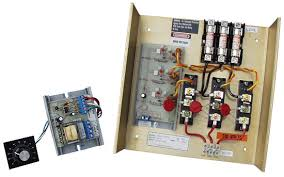SCR Power Controls and Electric Heat
For the past 50 years, analog-based designs have served industry well. However, increasing demand for design flexibility, improved reliability/repeatability and lower costs have made the intelligent SCR power supply an ideal solution for electric furnace users seeking to gain competitive advantage. Intelligent power supplies have many advantages over analog designs. This article reviews some of the challenges of legacy analog power supplies and the ways that intelligent SCR power supplies address them.
Data-Driven Performance
Intelligent power supply technology can enable higher performance, increased productivity and improved quality. The digital SCR power controller is the core building block of an intelligent SCR power supply. It’s advanced design blends the capabilities of a microcontroller, Ethernet communications and integrated I/O components.
Unlike analog designs, an intelligent power controller’s parameters are flexible and may be customized to suit a particular application. Proprietary algorithms and user-definable configurations are embedded in the microcontroller, stored, recalled and modified as needed. Energy efficient hybrid firing modes, nominal values, limits, alarms, math functions, logic and I/O configurations can be defined via menu selection, or be built using a pc-based function block editor, similar to those used in PLCs. An Ethernet port provides direct access to configurations, diagnostics and process data previously unavailable from analog designs.
For regulation, the intelligent power supply is a superior choice. It compensates for load impedance and line voltage fluctuations by producing accurate voltage, current and power regulation. Hybrid firing techniques, load management and automatic transformer tapping produce energy efficiencies far beyond the reach of analog designs. Power factors between 92% and 98% may be achieved across the entire load curve.
A well-regulated process depends upon power control with high-accuracy feedback. Intelligent SCR supplies are digitally calibrated to traceable RMS voltage, current and power standards. Their calibrations hold true and are not affected by temperature, dust or other contaminants like manually calibrated devices. With an intelligent SCR power supply, the furnace temperature is independent of electrical variations, because they are addressed by a self-regulating SCR power controller.
Improved Reliability
Analog power supplies have been reliably used for furnace applications for decades. One concern with replacing analog power supplies with intelligent technology is that of reliability. As with all custom designs, special consideration is given to the environment in which the power supply will be installed. In dusty, corrosive or humid environments the power and control electronics are housed in enclosures with the appropriate NEMA or IP protection rating.
Adequate cooling is vitally important. Typically, the PLC, HMI, SCR and other digital controls are installed on one side (control-side) of a compartmentalized enclosure. The other side (power-side) contains the transformer, tap connections/switches or other power connections. This separation also provides protection against electrical interference. Many times, a custom designed, intelligent SCR power supply can be installed in a footprint much smaller than its predecessor.
Reliability of an intelligent SCR power supply lies not only in its design but may be extended to include advanced diagnostics for heating elements. Condition monitoring helps eliminate downtime due to unexpected element loss. In condition monitoring, the characteristic impedance of a heating element is monitored across its operating temperatures and/or known life cycle. As the heating element approaches its end of life, the total load impedance increases and the setpoint eventually becomes unreachable triggering an alarm. The intelligent power supply can detect these conditions and notify the operator in advance of element problems allowing enough time to order replacement parts and schedule maintenance.
Full or partial load alarms work in a similar manner. The characteristic impedance of the load under normal conditions is measured and stored. When a series or parallel element is lost from the load circuit then the impedance increases by a known percentage. If the impedance increases beyond that percentage threshold an alarm sounds. If in constant power mode, the SCR power controller continues to precisely regulate output power, within user-defined voltage and current limits, while compensating for the lost heating element.
Lower Energy Costs
Energy efficiency is expressed in terms of power factor, which ranges between 0-100%. Intelligent power supplies reduce energy costs by employing power factor improvement techniques through hybrid firing. Hybrid firing modes produce much better power factors than analog designs. Additionally, peak kVA demand can be managed to avoid energy supplier demand penalties. In many cases, these energy savings can provide a payback in as little as 2 years (depending upon energy rates).
As mentioned, unregulated analog power supplies are sensitive to changes in supply voltage or load impedance. SiC (silicon carbide) heating element resistance can have as much as 20% variation between new elements. Additionally, element resistance can increase by over 300% across operating temperatures and/or over the life of the element. These variations in resistance compromise the performance of analog power supplies resulting in poor regulation and higher energy costs due to low power factor, THD (total harmonic distortion), core saturation, etc.
Mi2 (molybdenum disilicide) based heating elements can have significant resistance variation (up to 10x) between hot and cold temperatures. Current limitation is necessary to avoid damage to the elements or power supply. Intelligent power supplies can be designed to address resistance variations while maintaining the highest energy efficiency.
For example, in a typical MoSi2 application, the intelligent SCR can be configured in a pc-based function block editor for hybrid firing, which limits transformer magnetization and cold element inrush currents. As illustrated in Figure 4, the intelligent power supply first ramps the output towards the set point with phase angle firing and proportional current limit. Unlike a fixed current limit, a proportional current limit is linear and follows the output as a percentage of the setpoint. As the impedance of the MoSi2 heating element increases with its temperature, the SCR output also increases. The intelligent SCR automatically transfers from current regulation mode to burst (zero-cross) firing and power regulation to promote the highest energy efficiency possible.
Summary
The case for intelligent power controllers in electric heating applications is compelling. Increased competition and demand for tighter process controls have placed a stronger emphasis on reducing downtime, lowering costs and improving quality. Analog designs are no longer adequate to meet these needs. Developments in intelligent power control have produced significant advantages over traditional analog power supplies. Higher reliability through ruggedized designs and advanced diagnostics extends beyond the power supply to include condition monitoring of heating elements. The initial investment and operating costs of intelligent power supplies are significantly lower than analog designs. With enhanced energy saving features, payback periods can be as little as 2 years. Intelligent power supply technology also adds flexibility, connectivity and data management to meet today’s unrelenting demand for quality control and higher productivity.
This article was written by Stephen Kosik of Eurotherm.
If you have questions regarding Eurotherm products, give Sure Controls a call at 800-844-8405 or fill out a contact form online.

